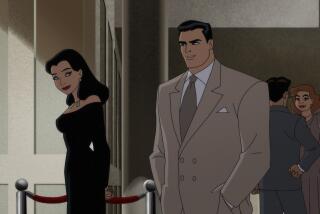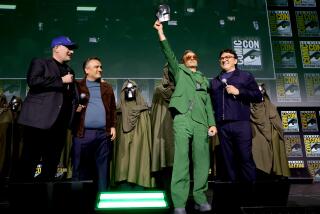‘Captain Marvel’: A brief history of Carol Danvers
Carol Danvers did not have any superpowers when she made her Marvel Comics debut, but she was always meant to be a star.
She’ll soon be seen soaring on the big screen in “Captain Marvel,” out March 8, as the first female superhero to headline her own movie in the Marvel Cinematic Universe. But while Brie Larson’s portrayal may serve as Carol’s introduction to film audiences, she has had a long comic book journey leading up to this live-action debut.
Since her first appearance as the security chief of NASA’s Kennedy Space Center over 50 years ago, Carol has gained powers, traveled through space, led the Avengers, battled alongside the X-Men, lost her memories and helped save the world — all before even assuming the mantle of Captain Marvel.
Comic-book Carol grew up with two brothers in Boston and has complicated feelings regarding her father, who refused to see girls and boys as equals. When he wouldn’t pay for her to go to college, she enlisted in the Air Force to fund her education and became a skilled pilot along the way.

Watch the trailer for “Captain Marvel.”
RELATED: ‘Captain Marvel’ directors draw on feminism and indie cred for a new kind of hero film »
A number of comic book creators have had a hand in shaping Carol and her story over the years, but the writer who has arguably had the greatest effect on her legacy so far is Kelly Sue DeConnick.
When DeConnick launched her landmark “Captain Marvel” run in 2012 with artist Dexter Soy, she described Carol as “an incredibly driven individual.”
“The single line that I use for her off the top of my head is: Crackerjack pilot races to prove dead daddy wrong,” DeConnick told The Times in 2012. “She’s always been trying to prove to her dad that she’s worthy. But her dad’s gone now, so it’s not a thing that she’s ever going to be able to get closure on.”
It was under DeConnick’s watch that Carol officially claimed the name Captain Marvel as her own, and this fan-favorite incarnation is what transformed her into a superhero destined to become a household name.
First introduced in 1968’s “Marvel Super-Heroes” No. 13 by Roy Thomas and Gene Colan, Carol was a NASA security chief keeping watch over an alien robot when she meets Dr. Walter Lawson — the human alter ego assumed by undercover Kree soldier Mar-Vell.
During her adventures with Mar-Vell, the first Captain Marvel, the pair got caught up in the explosion that destroyed an alien device called the Psyche-Magnetron. But it wasn’t until years later when the “Ms. Marvel” series launched that Carol discovered that the exposure to this device gave her superpowers.
It was long believed that the blast grafted Mar-Vell’s alien DNA onto Carol, altering her genetics and turning her into a half-Kree superhuman. But during the 2018 comic-book miniseries “The Life of Captain Marvel,” Carol’s mother was revealed to also be a former undercover Kree soldier.
Establishing that Carol is half-Kree by birth means her powers and potential have always been her own. Powers that include flight, super-strength, enhanced speed, increased resilience and the ability to absorb and fire energy blasts.
“She isn’t your average super-heroine,” “Ms. Marvel” No. 1 writer Gerry Conway said of Carol in the letters section of the 1977 issue. “Ms. Marvel … is influenced, to a great extent, by the move towards women’s liberation. She is … her own person. Herself.”
Proclaiming Carol and the “Ms. Marvel” series as intentionally feminist, however, has not protected her from problematic depictions and story lines over the years.
One of the most controversial was 1980’s infamous “The Avengers” No. 200. This issue saw Carol suddenly (heavily) pregnant with no recollection about how it happened. It turned out she had been kidnapped, brainwashed and impregnated with a version of her captor.
If that wasn’t problematic enough, after she gives birth she “willingly” leaves with her captor back to his original dimension and her Avengers teammates don’t bat an eye at the whole thing.
Former “Ms. Marvel” writer Chris Claremont later attempted to rectify some of the damage by having Carol call out the Avengers and cut ties with the team.
Losing her powers and memories in an encounter with Rogue brought Carol to Professor Xavier and the X-Men. There she was able to regain her memories but not the emotions attached to them.
1982’s “Uncanny X-Men” No. 164 (by Claremont and Dave Cockrum) saw Carol tap into some new cosmic-level energy-wielding powers and take the new name Binary.
After some adventures in space, Carol’s powers return to those that she had initially as Ms. Marvel. So when she rejoins the Avengers in 1998’s “Avengers” No. 4, Carol switches to another new code name: Warbird.
She eventually drops Warbird and goes back to using Ms. Marvel before eventually claiming Captain Marvel.
During this time, a number of other characters used the name Captain Marvel including Monica Rambeau (a human who gains superpowers after being exposed to extra-dimensional energy), Genis-Vell (Mar-Vell’s son created from his cells after his death) and Phyla-Vell (Genis’ sister he himself created when he re-created the universe. It’s complicated).
In addition to officially switching names, 2012’s “Captain Marvel” No. 1 saw the debut of Carol’s now iconic suit designed by artist Jamie McKelvie.
DeConnick has since passed on the “Captain Marvel” torch but Carol’s comic book adventures have continued in series from other creative teams which have included writers such as Michele Fazekas, Tara Butters and Margaret Stohl and artists Kris Anka and Ramon Rosanas.
Twitter: @tracycbrown
More to Read
The biggest entertainment stories
Get our big stories about Hollywood, film, television, music, arts, culture and more right in your inbox as soon as they publish.
You may occasionally receive promotional content from the Los Angeles Times.











